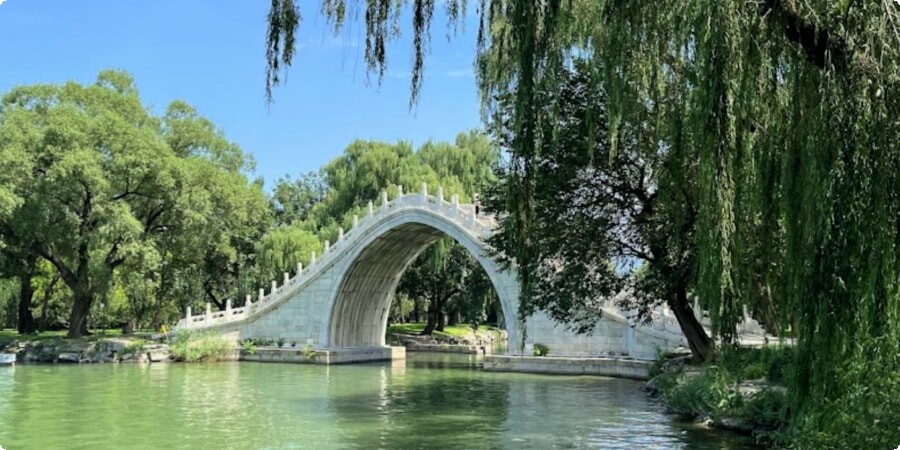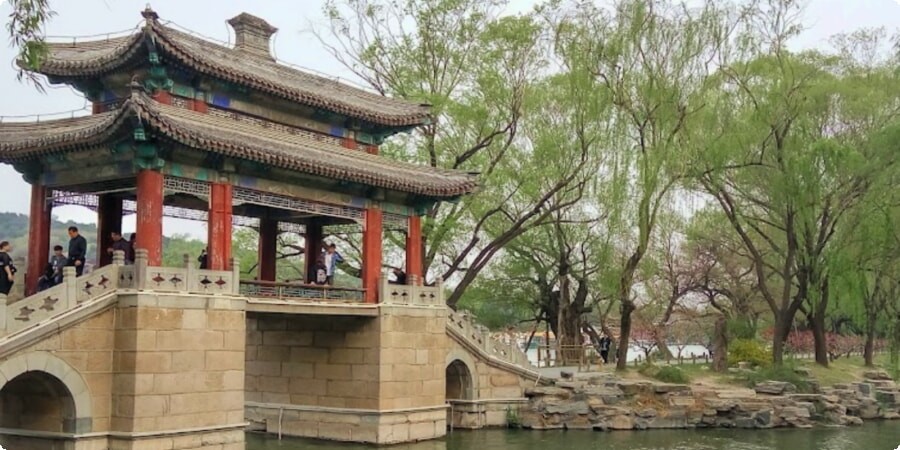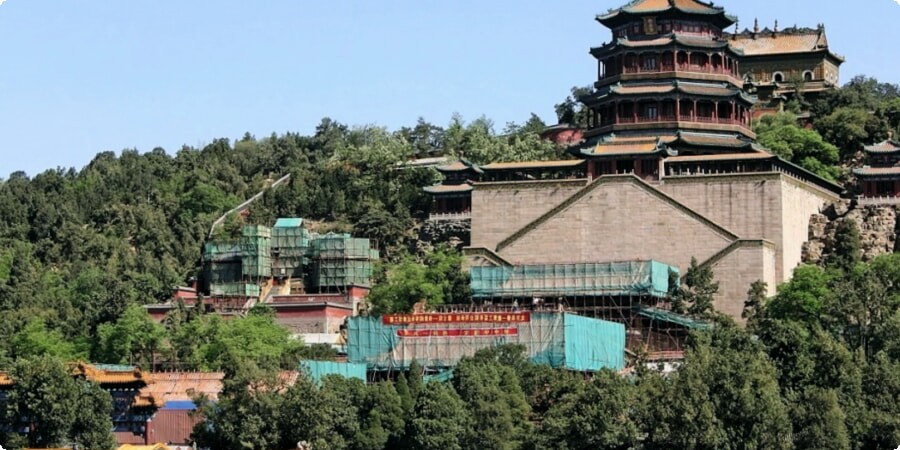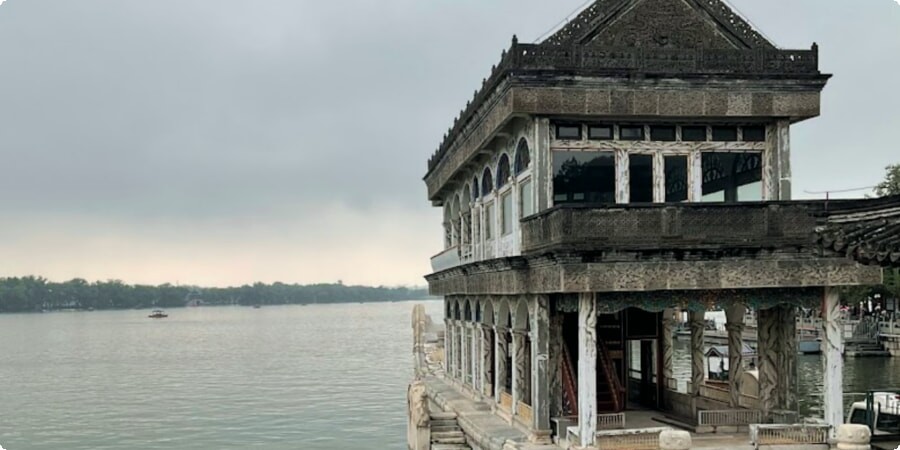Summer Palace Secrets: History and Highlights of Beijing's Imperial Garden
Nestled on the outskirts of Beijing, the Summer Palace is more than just a historic site—it's a breathtaking tapestry of China’s imperial past woven into the serene beauty of landscaped gardens and grand palaces. Recognized as a UNESCO World Heritage site, this vast complex of lakes, gardens, and palaces spans over 700 acres and offers a glimpse into the luxurious lives of China’s emperors and empresses.
Originally built in 1750, the Summer Palace has long been celebrated for its harmonious blend of natural beauty and human craftsmanship. The design of the palace grounds reflects traditional Chinese philosophies about balance and harmony, where each structure and garden serves a purpose, not just for aesthetics, but also for spiritual reflection and leisure.
Today, the Summer Palace remains one of Beijing’s most popular attractions, drawing millions of visitors each year who come to explore its lush landscapes and historical wonders. From the tranquil waters of Kunming Lake to the majestic Longevity Hill, the Summer Palace is a place where history and nature coexist, inviting visitors to step back in time and experience the elegance of imperial China.
A Glimpse into History: The Origins and Evolution of the Summer Palace
The story of the Summer Palace begins in the mid-18th century during the reign of the Qianlong Emperor of the Qing Dynasty. Enchanted by the natural beauty of the area, Qianlong ordered the construction of the palace as a gift for his mother’s 60th birthday. Originally known as the Garden of Clear Ripples (清漪园), the site was designed to be an imperial retreat away from the bustling city center, a place of rest and leisure for the royal family.
The Summer Palace's initial construction was a massive endeavor, involving the relocation of entire hills and the creation of Kunming Lake, which was modeled after the West Lake in Hangzhou. The palace quickly became a favored retreat for the emperors, providing a serene environment where they could escape the intense summer heat of Beijing.
However, the tranquility of the Summer Palace was shattered in 1860 when it was destroyed by Anglo-French forces during the Second Opium War. The palace was left in ruins until the 1880s when the notorious Empress Dowager Cixi diverted funds meant for the navy to rebuild it as her personal playground. Renaming it the Summer Palace, she lavished it with ornate pavilions, exquisite gardens, and luxurious halls, transforming it into a symbol of imperial extravagance.
In 1900, the palace was once again damaged, this time by the Eight-Nation Alliance during the Boxer Rebellion. But like a phoenix rising from the ashes, it was meticulously restored in the following years. Each restoration effort has sought to preserve its historical integrity, making the Summer Palace a living chronicle of China’s tumultuous past.
To explore this rich history firsthand, consider renting a car from Beijing Airport for a convenient and flexible way to reach the palace and other attractions in Beijing.

Architectural Marvels: Key Structures and Their Significance
The architecture of the Summer Palace is a masterpiece that reflects the grandeur and aesthetics of traditional Chinese design. At the heart of the palace complex is the Hall of Benevolence and Longevity (仁寿殿), the main administrative building where emperors once conducted state affairs. Its name is derived from a Confucian principle emphasizing virtuous rule, underscoring the connection between governance and moral integrity.
Another architectural highlight is the Tower of Buddhist Incense (佛香阁), which rises majestically on Longevity Hill, overlooking Kunming Lake. This towering structure, with its distinctive triple-eaved roof and intricate woodwork, served as a site for worship and meditation, offering a stunning view of the palace grounds and the distant cityscape. It is an embodiment of the fusion between religious devotion and imperial authority.
The Seventeen-Arch Bridge (十七孔桥) is one of the most photographed spots in the Summer Palace. Spanning across Kunming Lake, this elegant bridge connects the eastern shore to Nanhu Island. The bridge is adorned with over 500 carved stone lions, each uniquely designed, symbolizing protection and power. Walking across the bridge provides a sense of crossing from the mundane world into a realm of tranquility and imperial elegance.
Throughout the Summer Palace, you will also find numerous other structures, including pavilions, corridors, and halls, each with its own unique style and function. The long, covered Long Corridor (长廊), for instance, is famous for its painted beams depicting scenes from Chinese folklore and classical literature, offering visitors a colorful insight into traditional Chinese storytelling.
These architectural marvels not only demonstrate the craftsmanship of the time but also reflect the cultural and spiritual aspirations of the Qing Dynasty. By exploring these structures, visitors gain a deeper understanding of the imperial life and the philosophy that guided the design of one of China’s greatest palatial gardens.

The Art of Garden Design: A Harmony of Nature and Artifice
The Summer Palace is not just a showcase of imperial architecture; it is also a testament to the exquisite art of traditional Chinese garden design. The layout of the palace is a carefully orchestrated balance of natural and man-made elements, embodying the principles of harmony, balance, and symmetry. Every pond, hill, tree, and rock has been meticulously arranged to create a landscape that reflects the beauty of nature while enhancing it with human creativity.
At the heart of this design philosophy is Kunming Lake, an expansive body of water that occupies about three-quarters of the palace grounds. Modeled after the famous West Lake in Hangzhou West Lake, Kunming Lake serves as both a functional and aesthetic centerpiece. The lake was not only designed to irrigate the gardens but also to provide a serene setting that mirrors the surrounding hills and pavilions, creating a picturesque scene that changes with the seasons.
Longevity Hill (万寿山), standing at 60 meters high, complements Kunming Lake and provides a vantage point from which visitors can admire the entire palace. The hill is dotted with intricately designed buildings, including temples, pagodas, and the Tower of Buddhist Incense. The hill’s natural elevation is enhanced by these structures, which are strategically placed to draw the eye upward, creating a sense of ascension and enlightenment.
Throughout the palace, you will find carefully curated gardens filled with plants, trees, and flowers that were chosen not only for their beauty but also for their symbolic meanings. For instance, the willow trees that line the shores of Kunming Lake symbolize flexibility and resilience, while the lotus flowers that bloom on the lake’s surface represent purity and detachment from worldly desires.
The Garden of Harmonious Pleasures (谐趣园) is a smaller garden within the Summer Palace, designed to evoke the charm of southern Chinese water towns. This garden features winding paths, rock formations, and small bridges that crisscross over streams and ponds. It offers a tranquil retreat away from the more crowded areas of the palace, inviting visitors to lose themselves in its serene beauty and contemplative atmosphere.
The art of garden design at the Summer Palace goes beyond mere aesthetics; it reflects a profound understanding of nature, philosophy, and poetry, making it a living artwork that captures the essence of Chinese culture.

Cultural Significance: The Summer Palace in Imperial Life
The Summer Palace was more than just a retreat for the Qing Dynasty's imperial family; it was a vital part of their cultural and political life. This majestic estate served as a venue for important state functions, private celebrations, and spiritual reflection, making it an integral part of the imperial narrative.
Empress Dowager Cixi, one of the most powerful and controversial figures in Chinese history, is closely associated with the Summer Palace. After its destruction during the Second Opium War, Cixi diverted naval funds to rebuild the palace, transforming it into her personal summer residence. Here, she held court and entertained dignitaries, reinforcing her authority and showcasing the opulence of the Qing Dynasty.
The Summer Palace was also a place of leisure and relaxation for the imperial family. The Long Corridor (长廊), a covered walkway stretching over 700 meters along Kunming Lake, provided a shaded path for the emperor and his entourage to enjoy the garden's beauty without being exposed to the sun. The corridor is famously decorated with over 14,000 colorful paintings depicting scenes from Chinese mythology, history, and literature, reflecting the rich cultural heritage of the Qing court.
Furthermore, the Summer Palace played a significant role in the spiritual lives of the emperors. Temples and altars within the grounds were used for religious ceremonies and offerings, ensuring the favor of the gods and ancestors. The Tower of Buddhist Incense (佛香阁), for example, was not only a place of worship but also a symbol of the emperor's connection to heaven and his role as a mediator between the divine and earthly realms.
The cultural significance of the Summer Palace extends beyond its historical use. Today, it stands as a symbol of China's imperial past and a testament to the cultural and artistic achievements of the Qing Dynasty. It continues to inspire awe and admiration, drawing visitors from around the world who come to explore its magnificent halls and serene gardens.
For those planning to explore more of China's historical sites, renting a car can be a great way to travel with ease and flexibility. Consider booking a car through LuckyCar to make the most of your journey through China's rich cultural landscape.

Hidden Gems: Lesser-Known Spots and Secrets of the Palace
While the main attractions of the Summer Palace, like the Hall of Benevolence and Longevity and Kunming Lake, draw most visitors, there are many lesser-known spots within the palace grounds that are equally fascinating and rich with history.
One such hidden gem is the Garden of Virtue and Harmony (德和园), a secluded garden complex that was once used as a theater for the imperial family. Here, Empress Dowager Cixi enjoyed performances of traditional Peking Opera, surrounded by lush gardens and tranquil ponds. The garden features an impressive three-story theater stage, which is one of the best-preserved examples of its kind in China. The intricate wooden carvings and painted scenes within the garden make it a perfect place for visitors to escape the crowds and immerse themselves in a quieter, more intimate setting.
Another lesser-known area is Suzhou Street (苏州街), a charming section of the palace designed to resemble a traditional water town in southern China. This quaint street, with its arched bridges, winding canals, and shops, was built to provide a space where the imperial family could experience the ambiance of Suzhou without leaving Beijing. Strolling through Suzhou Street feels like stepping into a different era, offering a glimpse into the everyday life of ancient Chinese towns and the leisurely pursuits of the Qing emperors.
For those interested in the spiritual and philosophical aspects of the Summer Palace, the Hall of Jade Billows (玉澜堂) offers a unique experience. This hall was where Emperor Guangxu was placed under house arrest by Empress Dowager Cixi after a failed attempt to modernize China. The hall's serene surroundings, with its gardens and rockeries, contrast sharply with the historical drama that unfolded within its walls, providing a poignant reminder of the complexities of China's imperial history.
Exploring these hidden gems offers a deeper, more nuanced understanding of the Summer Palace beyond its main attractions. These quiet corners and secret gardens are where you can truly feel the layers of history that have shaped this imperial retreat into a living museum of China’s cultural heritage.
Exploring the Summer Palace Today: What to See and Do
Visiting the Summer Palace today is like stepping into a living museum, where every corner tells a story and every pathway leads to a new discovery. To fully appreciate this magnificent site, it’s helpful to plan your visit to make the most of its rich offerings.
Start your exploration at the East Gate (东门), which provides a grand entrance to the palace grounds. From here, you can head towards Kunming Lake, the sprawling body of water that forms the heart of the palace. Take a leisurely boat ride to enjoy the picturesque views of the lake and its surrounding landscapes. The boat rides offer a unique perspective of the palace’s architecture and the natural beauty of the area.
Next, make your way to the Long Corridor (长廊), a covered walkway renowned for its elaborate paintings. This corridor stretches over 700 meters and features over 14,000 paintings that depict various scenes from Chinese folklore and history. It's not just a walkway but a gallery that provides insight into Chinese cultural heritage and artistic expression.
From the Long Corridor, proceed to Longevity Hill (万寿山), where you can visit the Tower of Buddhist Incense (佛香阁). Climb up the hill to explore this iconic structure and enjoy panoramic views of Kunming Lake and the surrounding gardens. The tower’s intricate design and the surrounding pavilions are a highlight of any visit.
Don’t miss the Seventeen-Arch Bridge (十七孔桥), a marvel of engineering and design that connects the eastern shore of Kunming Lake to Nanhu Island. This bridge is adorned with detailed carvings and provides a perfect photo opportunity, especially at sunset when the light casts a golden glow on the stone arches.
If time allows, explore the Garden of Harmonious Pleasures (谐趣园), which offers a peaceful escape from the more crowded areas. The garden’s winding paths and tranquil ponds create a serene atmosphere, ideal for a relaxing stroll or quiet contemplation.
To enhance your visit, consider joining a guided tour to gain deeper insights into the history and significance of the Summer Palace. Tours often provide context and stories that enrich the experience and help you appreciate the palace’s cultural and historical importance.
Planning Your Visit: Tips and Practical Information
When planning your visit to the Summer Palace, a few practical tips can help ensure a smooth and enjoyable experience.
Getting There: The Summer Palace is located in the northwest of Beijing and is easily accessible by public transportation. You can take Bus No. 331, 332, or 345, or use the Beijing Subway Line 4 to reach the palace. For a more convenient option, consider renting a car for a personalized travel experience. Booking a car through LuckyCar allows you to explore Beijing and its surroundings at your own pace.
Ticket Information: The Summer Palace is open year-round, with tickets typically available for purchase at the entrance. It’s advisable to arrive early to avoid long lines, especially during peak tourist seasons. Tickets are generally affordable, and there are discounts available for students and seniors.
Opening Hours: The palace grounds are open from 7:00 AM to 6:00 PM, with extended hours during peak seasons. The various halls and pavilions may have different opening times, so check in advance to make sure you don’t miss any key attractions.
Guided Tours: For a more informative visit, consider joining a guided tour. Tours offer detailed explanations of the palace’s history, architecture, and cultural significance. They can be booked in advance through various travel agencies or directly at the palace.
What to Bring: Wear comfortable walking shoes as the palace grounds are extensive, and you’ll be doing a lot of walking. Bring a hat, sunscreen, and water, especially during the warmer months. If you’re visiting in the winter, dress warmly as temperatures can be quite low.
The Timeless Charm of the Summer Palace
The Summer Palace stands as a remarkable testament to China’s imperial heritage and natural beauty. Its grandeur and tranquility continue to captivate visitors, offering a glimpse into the opulent lifestyle of the Qing Dynasty’s emperors and empresses.
Walking through the palace grounds, you can feel the weight of history and the elegance of a bygone era. Each garden, pavilion, and corridor tells a story of cultural and artistic achievements, reflecting the sophisticated tastes of the Qing court. The harmonious blend of nature and architecture showcases the ingenuity of traditional Chinese garden design and the enduring legacy of imperial China.
Whether you are a history enthusiast, an architecture aficionado, or simply someone seeking a peaceful escape from the city, the Summer Palace offers something for everyone. Its picturesque landscapes, intricate structures, and historical significance create a rich and rewarding experience.
As you explore this magnificent site, take a moment to appreciate the beauty and history that make the Summer Palace a treasured gem of Beijing. Its timeless charm and cultural richness ensure that it remains one of China’s most cherished landmarks, inviting visitors to connect with the past and experience the splendor of imperial China.